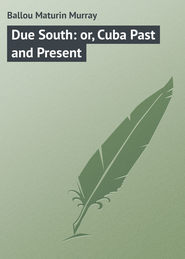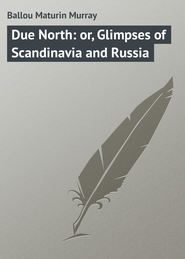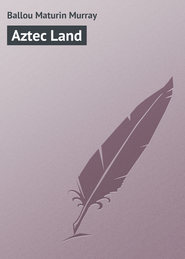По всем вопросам обращайтесь на: info@litportal.ru
(©) 2003-2024.
✖
The New Eldorado. A Summer Journey to Alaska
Настройки чтения
Размер шрифта
Высота строк
Поля
In some places, as we quietly glide close in to the shadow of the land, shut in by the morning fog and mist wreaths, the effects are very curious and even startling. It not being possible to see very far up the shrouded cliffs, down whose sides there rush narrow, silvery cascades, with a merry, laughing sound, they often have the appearance of coming directly out of the sky. It seems as though some peak had punctured one of the over-charged clouds, and it was pouring out its liquid contents through the big aperture.
The contrast between a voyage across the open ocean and a sail of two weeks in this inland sea is notable. In the former instance the voyagers find fruitful themes in the vast expanse and fabulous depth of the ocean, the huge monsters and tiny creatures occupying it, the record of the ship’s progress, her exact tonnage, and the trade in which she has been engaged since she was launched. Few persons have in themselves sufficient intellectual resources not to become oppressed with ennui under the circumstances. Between Puget Sound and Glacier Bay how different is the experience! There is no monotony here; every moment is replete with curious sights, every succeeding hour full of fresh discoveries. The panoramic view is crowded all day long with sky-reaching mountains, scarred by wild convulsions; verdant islands embowered in giant trees; rocky peaks rising from the bottom of the sea to a thousand feet and more above our topmast head; cascades tumbling down precipitous cliffs; Indian hamlets dotted by totem-poles; canoes gliding over the silent surface of the deep channels; inlets crowded with schools of salmon; mammoth glaciers emptying themselves into the sea and forming opaline icebergs sharply reflecting the sun’s dazzling rays. There is no time for ennui among such scenes as these; the eyes are captivated by the beauty and the variety, while the imagination is constantly stimulated to its utmost capacity.
The flora of this far northern country does not exhibit the wonderful luxuriance and productiveness which captivates us in the tropics, though one gathers some extremely attractive specimens. Neither the flowers, the insects, nor the birds are marked with the brilliancy of color which distinguish those bathed continually in waves of equatorial sunlight. Here, grandeur prevails over beauty; the trees, if not so verdant, excel in size and majesty; the mountains, in height; the rivers, in volume and length; while the glaciers are without comparison in magnitude and power. Here, is simplicity, vastness, magnificence; there, fertility, fragrance, loveliness. Neither in the north nor in the south is there the least infringement upon the great harmonies of Nature; admirable consistency and order exist everywhere, typifying a great, overruling, supreme Intelligence.
We pause for a moment amid the silent tranquillity to sum up our experience while gliding along this beautiful and peaceful inland sea on the return voyage. The author does not hesitate to pronounce Alaska to be one of the most attractive regions in the world for summer tourists. From early June to September the temperature prevailing upon the entire route is equable, the thermometer ranging all the while between sixty and seventy degrees Fah. The progress of the steamer always creates a gentle and agreeable breeze, which renders warm clothing desirable, especially at early morning and in the evening, though these are periods not so distinctly defined as with us in New England. An overcoat is rarely rendered necessary or desirable. If the mosquitoes are troublesome at certain places on shore, in marshy regions, they are never so on the water, as the breeze inevitably drives such insects away. Let us say especially there is no other such inviting resort for pleasure yachts as this inland, island-dotted sea of Alaska. If the fogs put in an appearance sometimes in the morning, they are after a while burned away by the warmth of the sun. Local rains on shore are to be occasionally endured, but they are no great drawback to observation and brief excursions. At Sitka, Wrangel, and Juneau several showers may occur during the day, with intervals of bright and cloudless skies between. We have witnessed seven copious, well-sustained showers of rain on a May forenoon in Chicago, the intervals sandwiched with sunshine of gorgeous clearness and warmth. Why pretend that Alaska is exceptional in this respect? The weather is not perfect, according to our estimate, anywhere. Finally the extended trip upon the boat was found to cover a little over two thousand miles in all, and was with us one of continuous pleasure, enlivened by as bright and cheerful weather as one experiences on an average elsewhere, winding among an immense archipelago of mountains, emerald islands, and land-locked bays, through narrow channels dominated by precipitous cliffs, and crossing broad, lake-like expanses as placid as the serene blue overhanging all.
No other government on the globe, in this nineteenth century, would permit so large and important a portion of its territory to remain unexplored. Congress should send at once a thoroughly equipped scientific expedition, competent to report minutely upon the geology, fauna, flora, and geography of this immense division of the country. It is more than an oversight, it is a gross blunder, not to do this without further delay. If our own pen-pictures of this neglected Territory shall incite to the fulfillment of such an act of official duty, these pages will have served at least one important purpose.
“With a comparatively mild climate,” says C. E. S. Wood, in an account of a visit to Alaska, printed in the “Century Magazine,” “with most valuable shipbuilding timber covering the islands, with splendid harbors, with inexhaustible fisheries, with an abundance of coal, with copper, lead, silver, and gold awaiting the prospector, it is surprising that an industrious, shipbuilding, fishing colony from New England or other States has not established itself in Alaska.”
The political condition of Alaska is anything but creditable to our country. It has little more than the shadow of a civil government, and is entirely without any land laws by which a resident can secure a title to the soil upon which he builds his house. The act of Congress dated May 7, 1884, providing an apology for a civil government, was not passed until twenty years after the Territory had been acquired. As a consequence the material progress of the country and its inviting possibilities remain undeveloped. With the extension of the United States local laws to this section, immigration would be at once promoted and various industries established. “Why we are so neglected is incomprehensible,” said a resident of Sitka. “All we ask is the same advantages enjoyed by the citizens of the other Territories of the United States.” It is certainly to be hoped that Congress will give early attention to this important matter, for Alaska is destined to become one of our most valuable possessions. We shall be excused for making use of so strong an expression, but it is only too true that her interests have been persistently and shamefully neglected by the law-makers at Washington.
“Like the dog in the manger,” says Miss Kate Field, “Congress will do nothing for Alaska, nor will it permit Alaska to do anything for herself locally, or at Washington through a delegate. Yet, in 1890, two islands of this despised and neglected province will have paid into the United States Treasury $6,340,000, – within one million of Alaska’s entire purchase!”
The present comparative isolation of Alaska will not be of long duration; not only are the facilities for reaching the Territory being annually increased from the east, but it is being also rapidly approached in this respect from the west. The Russian government is building a railroad in almost a straight line from Moscow to Behring Sea, which it is confidently believed will be completed within five years. Direct communication will thus be established between St. Petersburg and the Russian Pacific ports, through Siberia, whose most easterly point is less than forty miles from the soil of Alaska.
After sailing four or five days southward, bearing always slightly to the east, through a wilderness of islands and along the mountain-fringed coast of the mainland, the ship comes upon the open sea, and the passengers realize for a short time the effect of the Pacific Ocean swell. The sensitiveness of some people to its influence is as remarkable as the stolid indifference of others. Here, where the Japanese Current meets the cold air from off the coast, fogs are very liable to prevail, though it was not so in the writer’s case. We are now in comparatively open navigation and can lay our course without fear. Soon Queen Charlotte’s Sound is entered, and for a day and a half the steamer again skirts the picturesque shore of Vancouver, whose features are reproduced in the deep, quiet waters with marvelous distinctness, until finally we are once more landed at Victoria, the capital of British Columbia.
We are frequently asked since our return what clothing and other articles one should take, with which to make the inland voyage through Alaskan waters. This is easily answered.
As the rainfall is frequent be sure to have a good stout umbrella. Ladies would do well to take a gossamer waterproof and gentlemen a mackintosh. Heavy shoes, that is with double soles, and a light overcoat should be provided. There is no occasion for full dress, – court dress, on this route, swallow-tails are so much needless baggage. Ladies’ skirts should be short so they will not draggle on the wet deck of the steamer, or in walking through the damp grass, or over the surface of a glacier. In the latter instance gentlemen generally carry portable spikes that can be screwed on to the bottom of the shoes, and a staff cane with a stout ferule. When a party is formed to ascend a glacier a small hatchet and small rope should always be taken by some one of their number. In case of an accident these often become of great importance. There need not be any accident, however, if ordinary prudence is observed.
A large and well-appointed steamer named the Islander, which plies regularly on this route, takes one across the island-sprinkled Gulf of Georgia in six or seven hours from Victoria to Vancouver on the mainland. This is the terminus of the Canadian Pacific Railway, situated a short distance from the mouth of the Fraser River. From here the homeward course is almost due east through British Columbia, Alberta, Assiniboia, Manitoba, Ontario, and Quebec to Montreal, thence southeast to Boston.
So late as 1886 the present site of Vancouver was covered with a dense forest of Douglass pines, cedar and spruce trees. The Canadian Pacific Railway was completed to Vancouver in May, 1887, when the first through train arrived from Montreal. The youthful city is well situated for commercial purposes on what is called Burrard Inlet. It has extensive wharves, substantial warehouses, and very good hotel accommodations. Well-arranged public water-works bring the needful domestic supply in pure and healthful condition from the neighboring hills. The surrounding scenery is strikingly bold, embracing the Cascade Range in the north, the mountains of Vancouver Island across the water in the west, and the Olympian Range in the south, while the great snowy head of Mount Baker rears itself skyward as the main feature in the southeast. The steamer which brings us here from Victoria passes through a beautiful archipelago of peaceful islands, verdant and wooded to the very brink. The busy population of this infant city number between thirteen and fourteen thousand, and the place is growing rapidly. It is lighted by both gas and electricity. Forty substantial edifices for business and dwelling purposes are in course of erection at this writing. There are steamers which sail regularly from here for Japan, China, and San Francisco. As it is in the midst of what may be called a wild country, there is excellent hunting near at hand and large game is abundant. Many sportsmen, especially from England, make their headquarters here while devoting themselves to hunting for a large part of the summer season. Four large English sloops of war were observed in the harbor at the time of the writer’s visit, together with a couple of torpedo boats bearing the same flag, destined for Behring Sea, to “emphasize” the British side of the Alaska fishery question as between our government and that of Great Britain.
As one stands on the shore the harbor presents a picture of great variety and interest, comprising men-of-war boats pulled by disciplined crews; canoes, paddled by Indian squaws wrapped in high-colored blankets; boats loaded with valuable furs and propelled by aboriginal hunters; here a raft of timber, and there a steam ferry-boat. Just in shore there is passing as we watch the scene a native canoe carrying a sail made of bark-matting, brown and dingy, steered with a paddle by an aged, withered, white-haired Indian, while in the prow is a four or five year old native boy, trailing his hands idly in the water over the side of the tiny craft. A striking picture of the voyage of life: thoughtless, happy, vigorous youth at the prow, with weary age and experience awaiting the end at the stern. A couple of large steamers close at hand are getting under way loaded with preserved fish, put up at the canneries near by; one is bound for Australia, the other for England, by way of Cape Horn.
Vancouver has many edifices of brick and stone, with good churches and several schools; some of the private residences being remarkable for their complete architectural character in so new a city as this which forms the terminus of the Canadian Pacific Railway.
The principal part of the city occupies a peninsula, bounded north by the waters of Burrard Inlet, south by a small indentation called False Creek, and west by English Bay. The city is fast extending beyond these limits, both east and south. The peninsula rises gradually to an altitude of two hundred feet, more or less, affording the means of perfect drainage for the new city, which is laid out on a grand scale. A tramway, embracing the several suburbs, is in course of construction, the motor for which will be electricity.
We take the cars at Vancouver for our long journey homeward over the Canadian Pacific Railway, through the British Dominion to the Atlantic coast, indulging in a last admiring view of the grand elevation known as Mount Baker, which in these closing days of July is a mass of snow two thousand feet from its summit. Upon starting our attention is first drawn to the gigantic trees, big sawmills, immense piles of lumber, and extensive brick-yards in the environs of the city. Small villages are passed, straggling farms, Indian camps, mining lodges, and Chinese “hives,” where these people congregate after working all day at placer mining, and gamble half the night, sacrificing their laboriously acquired means. The grand winding valley of the Fraser River – a watercourse as large as the Ohio – is followed for over two hundred miles in a northeasterly direction, affording glimpses of most charming and vivid scenery, leading through cañons fully equaling in grandeur of form and beauty of detail anything of the sort in Colorado.
Now and again groups of Indians are seen preparing the salmon they have caught for winter use. The fish are split and stretched flat by wooden braces, then hung in long pink lines upon low frames of wood. They use no salt in this curing process, but simply dry the fish by atmospheric exposure, and succeed very well in thus preserving it. Dried salmon forms the principal staple of food for this people in the long Canadian winters. These natives, as in our own instance, are subsidized by the Dominion; that is, they are placed upon reservations and receive a certain amount of money and rations annually from the government. Light green patches of raspberries are passed here and there, where children are gathering the ripe fruit in abundance, the bright color about their mouths betraying how abundantly they have feasted while thus engaged. It was a pleasant picture to gaze upon under the pearly blue sky, where we were surrounded with the fragrant odor of pine and spruce, and the ceaseless music of hurrying waters.
At times the river rushes through deep rocky ravines, and at others expands into broad shallows with glittering sand bars, on which eager groups of miners are seen washing for gold. We cross a deep, cavernous gorge of the river on a graceful steel bridge, which, though doubtless of ample strength, yet seems of spider-web proportions, then plunge into a dark tunnel to emerge directly amid scenery of the wildest nature, set with huge bowlders and noisy with boiling flumes and roaring cascades, where color, splendor, and inspiration greet us at each turn, while every object is softened by the pale afternoon sunlight.
By and by we pass up the valley of the Thomson River, a tributary of the Fraser, finding ourselves presently in what is called the Gold, or Columbian, range of mountains, a grand snow-clad series of hills. Our route through them for nearly fifty miles is in the form of a deep, narrow pass between vertical cliffs, forming land channels similar to the water-ways which we have lately left behind us in the Alexander Archipelago.
At the small stations boys and girls board the cars with tiny baskets of luscious blackberries and ripe raspberries for sale, soon disposing of them to the passengers. These are picked within a dozen rods of the railway track, where they are seen in great abundance. Wild flowers beautify the roadway, among which the most attractive are the golden-rod, the bright pink fire-weed, the towering and graceful spirea, the wild musk with its large bell-shaped scarlet flower, the fragrant tansy, with snow-ball clusters of white, and big patches of the tiny wild sunflower, its petals in deepest yellow, while among the lily-pads dotting the pools of water, orange-hued lilies are in full and gorgeous bloom.
The scenery is strictly Alpine, but constantly varies as our point of view changes, and we thread miles upon miles of snow-sheds. Heavy veils of mist fringe the mountain-tops, and the tall peaks are wrapped in winding-sheets of perpetual snow. The rugged scenery is fine, but finer is yet to come. Still climbing upwards, we are presently in the Selkirks, threading tunnels, dark gorges, sombre cañons, and narrow passes to the summit of this remarkable range, forced onward by two powerful engines, one in the rear the other in front of the train.
At a point known as Albert Cañon the railway runs along the brink of several dark fissures in the solid rock, three hundred feet deep, through which rushes the turbulent waters of the Illicilliwaet River (“Raging Waters”). Here the cars are stopped for a few moments that the passengers may the better observe the boiling flumes of angry waters, flecked with patches of foam, and compressed within granite walls scarcely twenty feet apart.
In approaching Glacier House station, at a certain point the train ascends six hundred feet in a distance of two miles. This is accomplished by a zigzag course, utilizing two ravines which are favorably situated for the purpose; the consummation is a grand triumph of engineering skill. While passing through this winding course we are serenaded by a chorus of dancing rapids, foaming cataracts, and rushing cascades. Here the torrents and waterfalls are innumerable, first on one side then on the other of our slowly-climbing train, and finally on both the right and the left, gleaming with bright prismatic rays while moving with tremendous impetus. Sir Donald, the highest peak of the Selkirk Range, shaped like an acute pyramid, now comes into view, rising to eleven thousand feet above the level of the sea, and piercing the blue zenith with its inaccessible summit. It is named after one of the most active promoters of this transcontinental railway. Sir Donald sends down from its immense snowfields a ponderous glacier half a mile wide and eight miles long, presenting most of the characteristics of such frozen rivers, though lacking the grand effect of those so lately seen in Alaska, where they join the ocean in partially congealed form, thus producing thousands of icebergs. This Donald glacier is nevertheless equal to the average of European ones. The mountain has never yet been ascended. We were told that a thousand dollars and a free pass over the railway for life await the successful mountain-climber who reaches the summit.
In making our way through Beaver Cañon and Stony Creek Cañon, the highest timber railway bridge ever constructed is passed, three hundred feet high and four hundred and fifty long, supported by direct uprights. Safe enough, perhaps, but one breathes freer and deeper when it is passed.
It would seem as though mosquitoes could hardly thrive at such an altitude, but their number here is myriad, and their vicious activity at Glacier House station beggars description.
CHAPTER XXIV
In the Heart of the Rocky Mountains. – Struggle in a Thunder-Storm. – Grand Scenery. – Snow-Capped Mountains and Glaciers. – Banff Hot Springs. – The Canadian Park. – Eastern Gate of the Rockies. – Calgary. – Natural Gas. – Cree and Blackfeet Indians. – Regina. – Farming on a Big Scale. – Port Arthur. – North Side of Lake Superior. – A Midsummer Night’s Dream.
Rogers’ Pass, at an altitude of four thousand two hundred and seventy-five feet above the sea, is situated between two ranges of snow-clad peaks, whence a dozen glaciers may be seen in various directions, frigid and ponderous.
As we came through this remarkable pass, in the afternoon, dark clouds rapidly spread themselves over the sky, reinforced by others more dense and threatening, engulfing us suddenly in darkness. Then the artillery of the heavens rang out in such deafening reports as to stifle all attempts at speech. The discharges and echoes among the gloomy gulches and tall peaks mingled so rapidly that it was impossible to separate cause and effect. The rain was like a cloud-burst. The sharp flashes of lightning were so incessant and blinding that one sat with closed eyes and bated breath. The great locomotive could barely make way on the steep up-grade, the wheels having so much less hold upon the track when thus submerged. Passengers looked into each other’s pale faces in fear and amazement. Still the slow, regular throb, throb, of the iron horse was heard through the din of the thunder and the roar of rushing waters. We did move forward, – barely moved. To stop would be destruction; backward impetus would instantly follow, and no brakes are powerful enough to stop the train from a dash downward towards the plain if once it started in that direction. But stay. Soon there came a faint glimmer of light from out of the sky, gradually this increased, the dark pall of the heavens was slowly removed, and the afternoon sun burst forth with soft, ineffable beauty. The thunder sounded farther and farther away, the echoes ceased, and the throb, throb of the ponderous engine steadily held the long train and forced the great load onward.
At Field station, in the heart of the Rocky Mountains, we begin an ascent of twelve hundred and fifty feet with two powerful engines, where the roadway is cut out of the sides of nearly perpendicular cliffs to which it seems to cling with iron grasp, overhanging the roaring torrent of the Kicking Horse River, which flows at a fabulous depth below. Here we cross now and again trestle bridges, three hundred feet above some frightful gorge, or pass over a viaduct of great span. The highest point of the road is reached at fifty-three hundred feet above the level of the sea, or say just one vertical mile. This extreme elevation is about five hundred miles from Vancouver.
The scenery at this point is grand beyond description, thrilling the whole nervous system while we gaze at it and vainly strive to comprehend its vastness. The very excess of emotion makes one dumb. The most experienced traveler watches the changing scene with a vivid interest. So wild, so comprehensive, and so startling a natural panorama is rarely met with in any land. A longing comes over the observer to divide the ecstasy of the moment with the loved ones left behind. No joy is complete which is not shared; it is no hermit quality, but was born a twin. Mountains, valleys, glacier-bound peaks, domes, spires, and snow-capped pyramids are seen in all directions, brought out in minute detail by the singular clearness of the atmosphere. Tall forests are spread out far, far below our feet, the mammoth trees looking no larger than pen handles, while the river winds like a broad silver belt through the green sward of the valley. Thus the Canadian Pacific Railway passes for hundreds of miles along glacial streams in full sight of the frozen rivers which feed them.
By and by we come in view of Castle Mountain, five thousand feet in height, which, with a little help of the imagination, becomes a giant’s keep, turreted, bastioned, and battlemented. At another point of view it presents a remarkable resemblance to the grand Indian Temple of Tanjore. A short distance farther and we reach Banff, where a couple of days were most agreeably passed by the author. The railway station here is in the midst of sky-piercing heights, whose first impression upon the traveler is both solemn and lonely. To the northward stands Cascade Mountain, nearly ten thousand feet in height; eastward is Mount Inglismaldie, beyond which looms up the sharp cone of Mount Peechee, reaching more than ten thousand feet into the blue ether. Close at hand rises the thickly wooded ridge of Squaw Mountain, in whose shadow lie the beautiful Vermilion Lakes, the home of myriads of wild geese and ducks. Other mountains are in view, but in the memorable tableau which we recall the grand peaks we have mentioned are the most prominent.
This is the station for the Rocky Mountain Park, the altitude being forty-five hundred feet above the sea. At this point the Canadian government has established a national reservation after the plan of our Yellowstone Park, between which and this place lies five hundred miles of the wildest sort of country. There is no comparison between the two parks, either in size, importance, or natural wonders. This reservation is twenty-six miles long by ten in width, embracing portions of three rivers, with two considerable lakes, cascades, and waterfalls. The scenery could not be otherwise than bold, being in the midst of such a mountain range and surrounded by such monarch elevations. Money is to be freely expended in making good paths, together with convenient avenues and bridges.
The Pacific Railway Hotel at Banff is a large, admirably situated, and picturesque establishment, designed to accommodate from two to three hundred guests at a time, and is especially patronized by Canadian bridal parties. The view from it is superb, commanding the winding course of the Bow River and valley for miles, with the many adjacent mountains. The river pours swiftly down from its sources among the snow fields, and plunges seventy feet over rock and precipice close beside the hotel, passing almost beneath our feet as we stand upon the broad piazza, gazing in admiration at the grand scenic carnival, and listening to the thrilling anthem of the rushing waters, while breathing the soft aroma of the Douglas pine and cedar forests which cover the surrounding slopes. The region in proximity to the hotel will give the lover of fishing ample sport. Trout of large size abound in Devil’s Lake near at hand. A guest brought in forty pounds of this gamey fish, caught in two hours’ time in the lake, while the author was at Banff. Wild sheep and mountain goats abound in the neighboring hills, while bears are more numerous than is desirable. Wildcats, mountain lions, deer, and caribou are also frequently shot by the hunters. The restriction as to use of firearms which is established in the Yellowstone Park does not apply in this region. Sportsmen roam where they please and freely hunt the wild animals which roam in this section of the country. Good roads and bridle paths take one in all directions among some of the finest scenery of the Rocky Mountains, where we watch the morning sun dispel the mist which floats upward and away, disclosing the snow-decked peaks in their virgin whiteness blushing roseate tints at the ardor of the sun.
This is called the eastern gateway to the Rocky Mountains, through which the grand Bow River flows on its diversified journey of fifteen hundred miles to Hudson Bay.
There are extensive hot springs on the eastern slope of what is known as the Sulphur Range, some six thousand feet above the sea level. They are at different elevations, and have good bathing-houses erected over them, in charge of courteous attendants. One of the springs is inside of a dome-roofed cave, which is a favorite resort of visitors to Banff. The medicinal character of these springs is considered so important that an iron pipe two miles in length conducts their heated waters for use at the hotel, the normal temperature being sustained by metallic coils of superheated steam. It rains much and often in this region. The weeping clouds make one feel rather gloomy, purely out of sympathy for their ceaseless tears, but when the sun finally asserts his power and lifts the misty veil, then come forth in hold contrast silvery, sparkling, sky-reaching mountains, covered with their frosty mantles, together with richly wooded valleys and river-threaded cañons, opening views of unrivaled sublimity and grandeur.
At Anthracite, five hundred and seventy miles from Vancouver, we are forty-three hundred and fifty feet above the sea. Here are the remarkable coal mines located in the Fairholme Range, a true anthracite of excellent quality and of great importance to the railway. The pass through which the road takes us is four miles wide, great masses of serrated rocks rising on either side, back of which mountains tower above each other as far as the eye can reach, forming long vistas of lofty elevations so numerous as not to bear individual names.
At Calgary, about a hundred miles farther eastward, we are still thirty-four hundred feet above the sea. This is a particularly handsome and thriving young town, scarcely four years old, but containing three thousand inhabitants. It is pleasantly situated on a hill-girt plateau, in full view of the jagged peaks of the Rockies, thirty or forty miles away, and which, as we look back upon them, form a vast blue and white crescent extending around the western horizon. Two placid rivers, the Bow and Elbow, wind through the broad green valley, adding a charming feature as they mingle with the tall waving grass. Here cattle and sheep ranches abound, extending westward to the very foot-hills of the great mountain range, and stretching far away to the southward a hundred and fifty miles to the United States boundary line. We were told that the cattle and horses ranging over this space would aggregate two hundred thousand head.
As we passed through the Province of Alberta at night, occasionally jets of flaming natural gas, which finds vent through the soil from reservoirs located at unknown depths, were burning brightly to light us on the way. This gas, so liberally supplied by nature free of cost, is utilized to create a motive power at Langevin, where it pumps water for the use of the railway. Representatives of the aboriginal Cree and Blackfeet tribes form picturesque groups along the railway line, composed of barbarous, uncleanly looking squaws and bucks, the latter only kept from the warpath by the presence of the efficient mounted police.
The contrast presented in emerging from the mountain ranges on to the level country is very remarkable. For hundreds of miles we pass through an almost uninhabited, treeless country, a long, long reach of prairie as boundless as the sea, and where no more of human life is seen than on the ocean. There are no hills, scarcely any undulations; the sun rises apparently out of the ground in the early gray of the morning, and sets in the endless level of the prairie at night. Small stations, twenty or thirty miles apart, have been built by the Canadian Pacific Railway Company, consisting of a dwelling-house and a water-tank for the necessary supply of its engines, but the line is thus characterized through a thousand miles, where there is no way travel, and no local business, outside of its own necessities. The inference is plain that it crosses this distance at extraordinary expense, which must be supported by the terminal business on the Pacific and Atlantic ends of the road.
The Cree and Blackfeet tribes are said to have no religion and few superstitions, being a restless, dangerous race, ranking very low in point of intelligence, even as savages. The efforts of the missionaries, we were told, have entirely failed to civilize or even permanently to improve the condition of the two tribes we have named. The women are hideously ugly, smeared with vermilion, and weighed down with cheap brass rings and bracelets of the same metal. The one article of sale offered to the traveler by these tribes is the polished horns of the buffalo, picked up upon the vast prairies of this region where they have been bleaching for many years. These are colored black by some process, and when highly polished are mounted in pairs, as they are placed by nature on the animal’s head.
At Regina, eleven hundred miles from Vancouver, we are still two thousand feet above the sea. This is the capital of the Province of Assiniboia, situated in the centre of an almost boundless plain. Here are the headquarters of the Northwestern Mounted Police, a very necessary military organization of a thousand men, distributed over this region to look after the Indians, who are ever ready to commit depredations when they feel they can do so with impunity, and also to preserve good order generally among the several frontier communities. It was at Regina that Louis Riel, the principal promoter of the late rebellion against the Dominion government, was tried and hanged not long since. It is called here the “half-breed rebellion.” Over the far-reaching, trackless, arid prairies, as lonely as an Egyptian desert, the cloud effects towards the day’s close are noticeably very fine, while the twilight lingers to the very verge of night. At times we pass through a broad tract of land ten miles or more square, from which a whole forest has been swept by conflagration, probably started by an unfortunate spark from a passing locomotive, or, quite as likely, by the carelessness of some camping party of sportsmen. These large spaces, which would otherwise be intensely dreary, are already carpeted with a fresh green undergrowth, with which nature always hastens to obliterate the devastation caused by the ruthless flames.
As our train stopped briefly at Regina a group of mounted Blackfeet Indians dashed across the prairie and drew up near the station. A wild, weird score of semi-savages, very picturesque in their garments of many colors and their decorations of quills, beads, and feathers, with a scalp hanging from the waist here and there among them. Their long, unkempt black hair flowed all about their necks and features, which were more or less besmeared with vermilion. Their leggings of deer-hide were fringed on the outer side, and their leather moccasins were lashed with deerskin thongs up the ankles. Some had stirrups, but most of them had none, their limbs hanging free and a blanket serving for a saddle. Their little wiry ponies were under complete control, and the riders were good horsemen. It seemed to be some gala occasion with these Blackfeet, but of what purport it was impossible to discover. They were evidently under a certain degree of discipline, for at a sharp, sudden command from one of their number they all dismounted together and stood with one arm over their horses’ necks like so many stone statues. At that moment a lady passenger in our car aimed her “kodak” at them, and, presto! they were photographed in the twinkling of an eye, which, considering their aversion to the process, was quite an achievement on the lady’s part. These Indians are now peaceable enough, and no one fears to go among them, but we are inclined to think, with “Buffalo Bill,” that they will make one more desperate fight, in both Canada and the States, before they finally give up the struggle with the white man.
Forty miles eastward from Regina we come to Indian Head, which is about three hundred miles west of Winnipeg, where the road passes through the famous Bell Farm, an extremely interesting and successful agricultural enterprise. It is managed by Major Bell, an ex-army officer of marked executive ability, and covers an area measuring one hundred square miles, being probably the largest arable farm in the world. Major Bell carries on the business for an incorporated company, and devotes the rich prairie loam, of which the soil is composed, mostly to the raising of wheat, employing in the various departments over two hundred men. The announced object of the company is first to bring the whole of the land under good cultivation, at the rate of five thousand acres or more annually, and when this is accomplished to divide the whole into two hundred and fifty farms to be sold to the employees, each provided with suitable dwelling-houses and buildings, all to be paid for by the purchasers in easy annual installments; a most beneficial purpose, and if it is fairly and honorably carried out it will be one which is deserving of all praise. It must inevitably build up a responsible and self-respecting community, by uniting proprietorship and domestic relations of the most desirable character, connected with steady and remunerative occupation.
The country lying between Indian Head and Winnipeg is mostly of a prairie character, rich in agricultural resources but of no special interest otherwise. Winnipeg, the capital of Manitoba, is very nearly midway between the Atlantic and Pacific oceans. It has some twenty-three thousand inhabitants, who live upon a site which was fifteen years ago known as Fort Garry, only a fur-trading station, said to be hundreds of miles from anywhere. To-day it has long, broad streets of public buildings, fine dwelling-houses, hotels, stores, banks, and theatres, besides large manufactories in various branches of trade. It is the Chicago of Canada. Situated where the forests end and the prairies begin, with river navigation in all directions, and with railways radiating from it towards all points of the compass, everything tends to make Winnipeg the commercial metropolis of the British possessions in the Northwest. Main Street, Winnipeg, is a fine boulevard one hundred feet wide and two miles long, lined from end to end with attractive buildings. One practice observed here recalled the native city of Jeypoor, India, namely, the driving of single oxen to harness between the shafts of light carts, the animal being guided by rope reins attached to the horns.
From Winnipeg to Port Arthur, which is beautifully situated on the north side of Lake Superior, the route is through a country characterized by a maze of forests, lakes, and rivers; a region more than half wilderness. Few evidences of civilization are found hereabouts; the primeval forest is full of game, the streams abound in fish, and the ponds are covered with wild fowl. Occasionally a group of Indian wigwams is seen, or a lone native Chippeway paddling his birch canoe. Now and again a hunter’s camp is passed, whose occupants come down to the railway to see the passing train, and who eagerly seize upon any current newspaper which thoughtful passengers toss to them from the car windows, a courtesy they gratefully acknowledge cap in hand.
Port Arthur, just one thousand miles from Montreal, is admirably situated on Thunder Bay, where the view is striking and beautiful, overlooked by the bold headland known as Thunder Cape, which rises fourteen hundred feet above the surface of the lake. Just upon the edge of the horizon is seen Silver Islet, which has heretofore proven to be one of the richest silver mines known to our times; but the mine is now hopelessly submerged, its tunnels and shafts flooded beyond relief by the waters of Lake Superior. These broad waters are dotted with white sails, and streaked with the long black lines of smoke trailing after huge steamers.
From here, for more than one hundred miles, the sharp curves of the great lake on its northern shore are closely followed by the Canadian Pacific Railway, and here the engineer’s skill has been wonderfully displayed in surmounting apparent impossibilities. We were told that it cost more per mile to build this portion of the road than it did to lay the rails through an equal distance in the difficult passes of the Rocky Mountains. The roadway is sometimes cut through solid rock, and sometimes an abrupt cliff is tunneled, from whence we emerge to leap across a deep ravine upon a wooden trestle of frightful curve and great elevation. And so we rush onward through unbroken forests and scenery of wildest aspect among barren rocks, scorched trees, and dense thickets of scrub on our homeward way.











